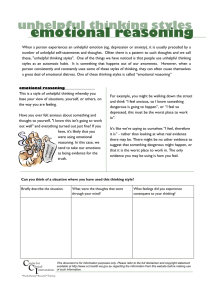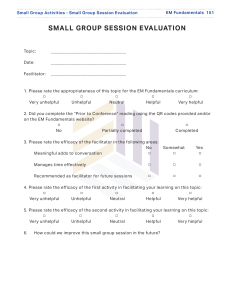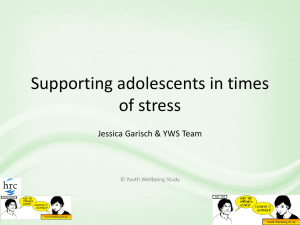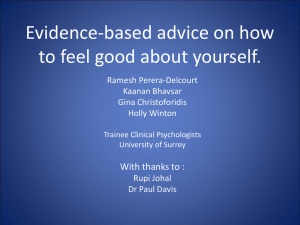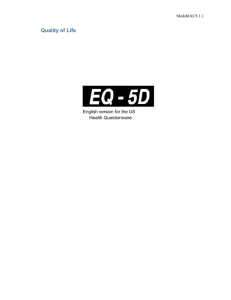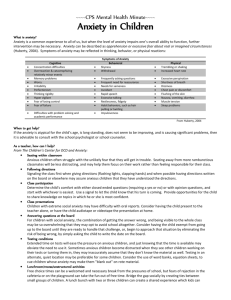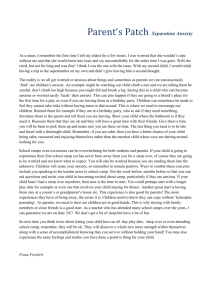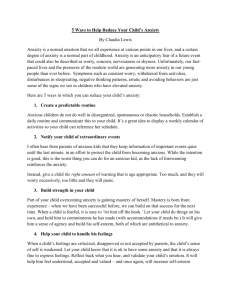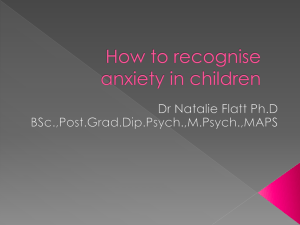Characteristic changes in thinking in anxiety disorders
advertisement
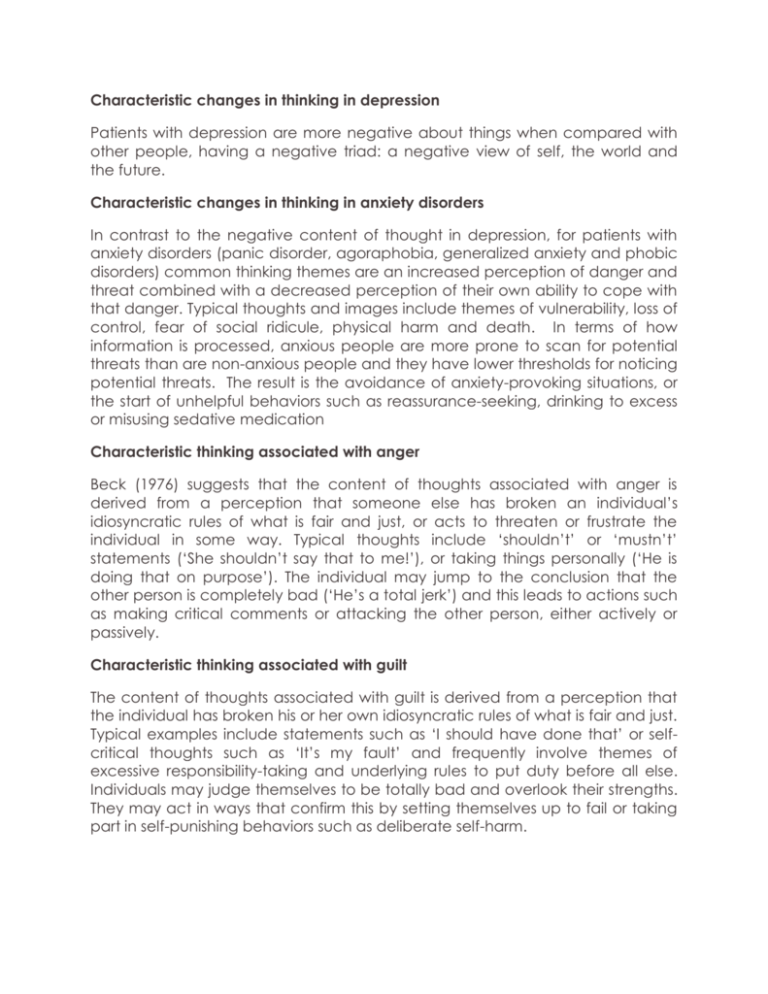
Characteristic changes in thinking in depression Patients with depression are more negative about things when compared with other people, having a negative triad: a negative view of self, the world and the future. Characteristic changes in thinking in anxiety disorders In contrast to the negative content of thought in depression, for patients with anxiety disorders (panic disorder, agoraphobia, generalized anxiety and phobic disorders) common thinking themes are an increased perception of danger and threat combined with a decreased perception of their own ability to cope with that danger. Typical thoughts and images include themes of vulnerability, loss of control, fear of social ridicule, physical harm and death. In terms of how information is processed, anxious people are more prone to scan for potential threats than are non-anxious people and they have lower thresholds for noticing potential threats. The result is the avoidance of anxiety-provoking situations, or the start of unhelpful behaviors such as reassurance-seeking, drinking to excess or misusing sedative medication Characteristic thinking associated with anger Beck (1976) suggests that the content of thoughts associated with anger is derived from a perception that someone else has broken an individual’s idiosyncratic rules of what is fair and just, or acts to threaten or frustrate the individual in some way. Typical thoughts include ‘shouldn’t’ or ‘mustn’t’ statements (‘She shouldn’t say that to me!’), or taking things personally (‘He is doing that on purpose’). The individual may jump to the conclusion that the other person is completely bad (‘He’s a total jerk’) and this leads to actions such as making critical comments or attacking the other person, either actively or passively. Characteristic thinking associated with guilt The content of thoughts associated with guilt is derived from a perception that the individual has broken his or her own idiosyncratic rules of what is fair and just. Typical examples include statements such as ‘I should have done that’ or selfcritical thoughts such as ‘It’s my fault’ and frequently involve themes of excessive responsibility-taking and underlying rules to put duty before all else. Individuals may judge themselves to be totally bad and overlook their strengths. They may act in ways that confirm this by setting themselves up to fail or taking part in self-punishing behaviors such as deliberate self-harm. Characteristic thinking associated with shame The content of thoughts associated with shame is derived from individuals’ perceptions that they have undesirable qualities (e.g. physical appearance, emotions, personality traits) or behaviors/actions which, if revealed to others, will result in ridicule and humiliation. The thought that they are total failures and that others see them in this way drives their behaviors, which aim to hide these undesirable qualities ‘When you were in the pub with your friends at what point did you feel most anxious?’‘ How anxious did you feel at that time on a scale of 0 to 10, where 0 is feeling no anxiety at all and 10 is the most anxious you have ever felt?’‘ At that moment when you came back from the bathroom and your friends were all laughing and you felt 95% anxious, what was going through your mind?’ ‘When you noticed the thought “They think I’m an idiot and will end up rejecting me”, how much did you believe it at the time, on the same 0 to 10 scale?’‘ Is it possible that that thought and how anxious you felt are linked?’ The aim of this series of questions is to identify and rate the belief in an extreme and unhelpful thought, and at the same time teach the Individual skills in recognizing the links between his thoughts and feelings. Table 1 Identifying unhelpful thinking styles (from Williams, 2001) Unhelpful thinking style Typical extreme and unhelpful thoughts Bias against myself I overlook my strengths I focus on my weaknesses I downplay my achievements I am my own worst critic Putting a negative slant on things (negative I see things through dark- mental filter) tinted glasses I tend to focus on the negative in situations Having a gloomy view of the future (making negative predictions/jumping to the worst I make negative predictions conclusion: catastrophizing) about the future Unhelpful thinking style Typical extreme and unhelpful thoughts I predict that things will go wrong Negative view about how others see me (mind- I mind-read what others reading) think of me I often think that others don’t like me Bearing all responsibility I often take things to heart I take the blame if things go wrong I take unfair responsibility for things that are not my fault I often use the words ‘always’ and ‘never’ to Making extreme statements/rules summarize things I make ‘must’, ‘should’ or ‘ought’ statements to myself I use the word ‘typical’ a lot to describe things that go wrong Catch the negative thought: Keep a journal, taking notes of the actual thoughts you are thinking when you’re in a situation that upsets you and ends in selflimiting and self-sabotaging behavior. Example: ‘It’s going to be awful, I’m going to embarrass myself…’- (and then avoiding an event). Thought Stopping: As you notice yourself saying these negative automatic thoughts, you can stop them mid-stream by saying to yourself “STOP”. Saying it aloud, or silently in your head if you are with people. You might also wear a rubber band around your wrist, giving it a little twang each time you notice you are allowing negative thinking to take over your head in a never-ending loop. It will make you more aware of how often, and in what situation, you are having the negative thoughts. Challenge the negative thought: Challenge the thoughts, examine them to see if they’re valid. ‘Where’s the evidence for this? Is there another way to look at it?’. Example: ‘Actually, that’s fortune telling, I don’t actually know what’s going to happen, all I can do is my best, maybe I’ll be a bit anxious, I can cope with that if it happens, and it might not happen, I was okay last week at that other event even though I tortured myself before it with this kind of thinking….’ Summary: reframe and replace: Note the negative thought – stop it in its tracks – examine it for evidence – and if you decide it is irrational and unhelpful, replace it with alternative healthy thinking. The Ellis idea is that we have distorted thinking about: How *I* am: e.g. I must be successful and respected and attractive all the time, or else I can’t be happy. How *you* are: e.g. You should be kind and respectful and loving toward me all the time, or else you’re a terrible person (or I’m a terrible person), and I can’t be happy. How *the world* is: e.g. Things ought to be comfortable and as I want them to be all the time, or else it’s awful, I can’t stand it, it’s unbearable – and I can’t be happy.
